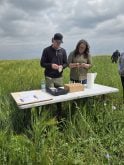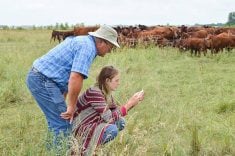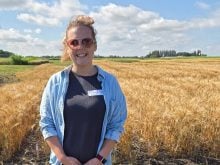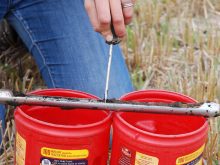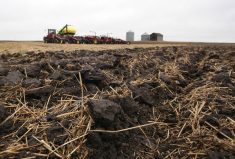Controlled traffic farming has yet to catch on in a big way in Western Canada, but the extreme conditions over the past two years have shown its worth to two long-term practitioners on opposite ends of the Prairies.
“I grew canola and barley last year and we had 28-bushel canola on four and a half inches of rain and five weeks of smoking hot weather,” says Steve Larocque, an agronomist at Three Hills, Alta., who has a small cropping operation. “Neighbouring fields were like 20 to 18. Dismal.”
In controlled traffic farming (CTF), all equipment is run on the same tracks, called tramlines, year after year. That limits compaction to just those tracks, improving water infiltration and soil health in the rest of the field.
Read Also

Marking Manitoba’s progress on economic reconciliation and agriculture: National Day Truth and Reconciliation
Manitoba wants to foster agricultural partnerships with Indigenous communities, but there’s still a lot of work to do.
There’s no secret about why non-compacted soil produces better crops.
“The whole premise of CTF is to allow that soil to breathe, to open up and repair itself over time. It adds a lot of aeration and porosity,” says Larocque.
However, it’s not only dry soils in which the technology excels.
“I think where CTF really shines for us is in a season like this, where it’s too wet,” says Adam Gurr, a CTF practitioner near Brandon and one of few prairie farmers fortunate enough to escape last year’s drought.
“We operate in two different areas. We have a farm near Brandon and another 15 miles north of Brandon. North of Brandon, we had ideal rainfall during the whole season. And we haven’t really had what I would call a true drought here since we adopted CTF.”
Why it matters: Farmers with a few years of experience in the system say it has many benefits.
In his experience, Gurr says too much moisture is a more common problem.
He started experimenting with CTF in 2011, committed to the system in 2012 and has been doing it ever since. He says the biggest soil compaction issues occur during spring activities.
“If you apply spring fertilizer and it’s too wet, or you’re doing operations to try and dry the soil out, there’s a lot of compaction occurring,” he says. “And if you don’t do it in a controlled way, you can get upwards of 50 per cent of your field area that’s experiencing some real compaction.”
“That’s going to limit crop growth, at least for that year.”
Gurr says he only drives over 10 to 15 per cent of his field area to put the crop in using CTF.

Although widely used in Australia, CTF has been slow to catch on in Canada, says Larocque, who became an advocate after receiving a 2007 Nuffield scholarship and seeing it in action Down Under.
There is a significant learning curve involved and the not inconsiderable problem of having equipment align with the tramlines for wheel spacing and equipment width. As well, there isn’t an immediate financial incentive to change, says Larocque.
“Why would you change when you’re making money? People are taking baby steps.”
However, the benefits go beyond reducing overall compaction because tramlines allow farmers to start seeding or harvesting earlier when field conditions are wet. It makes in-crop applications easier and reduces fuel use and machinery wear.
For Gurr, CTF has the added benefit of assisting him in his agricultural research business.
“We do a lot of on-farm research, so having all of our equipment being multiples of our combine header width really simplifies things and also improves the quality of the data that we’re collecting when we’re doing on-farm research trials.”
For farmers interested in converting their operations to the practice, Larocque recommends focusing on sprayers and combines to start because both machine tracks can be matched. Appropriate GPS technology is required.
“You can start up by just running tramlines on your sprayer, and you can tiptoe your way into it. You don’t have to go all in,” he says. “In many cases, it’s a gradual process and something that you move towards.
“So start with your sprayer, maybe add in your combine, and get your logistical head wrapped around it. A lot of the time, we are our own worst enemies —we can think of a million reasons why it won’t work.”
Grain carts are one of the worst soil compaction offenders, says Larocque, noting machine speed and weight add to compaction. But grain carts can be run on tramlines despite farmers thinking it’s more challenging.
“The weight you add and the faster you travel, the bigger the wave, the harder it is,” he says. “So, the grain cart is logistically challenging. On big fields, a lot of times they’ll just split a field in half and have a turnaround, so you don’t have to go all the way down to the end. Split a half section into quarters, which most farmers do anyway, when you’re blocking it out.”
Controlled traffic farming can dramatically reduce input costs (including fuel, time, and machinery wear) while increasing yields and profitability, says the National Institute of Agricultural Botany in the United Kingdom.
“Some farmers in Australia have cut their machinery costs by as much as 75 per cent while their crop yields have risen,” says the organization on its website.
Getting into fields because they absorb moisture, be it spring snow melt or fall rain, can also have a big impact on the bottom line, added Larocque.
“I don’t know how you put a value on timeliness, but it’s big. We can travel down fields much sooner and much easier.”
Can CTF take off in Canadian agriculture?
“Certainly, in drier areas. I’d be all over it if I were in a drier area,” says Larocque. “Anywhere you really need to have resilience, whether it be floods or droughts, that’s where CTF shines.”
Gurr also sees the adoption of CTF as dependent on areas more susceptible to yield loss arising from soil compaction.
“I can’t speak for other areas, I just know our own experience, where we’re dealing with wetter soils on a very regular basis, there’s value,” he says.
But even where the benefits are clear, the steep learning curve associated with CTF can be a limiting factor in terms of adoption.
“Every year I get a call from a producer who’s looking to go down that CTF road,” Gurr says. “It just takes some planning.”
Scott Keller, who grows wheat, barley, canola, peas, fava beans, oats and winter wheat near Camrose, is another CTF practitioner and advocate. He has been using zero till since the 1990s and says with good quality GPS, CTF is the next step.
“One of the important things with CTF is to get down to that repeatability of trafficking,” says Keller, who began transitioning in 2014.
The process of switching equipment took several years, but the effort was worth it, he says. Being able to work in wet conditions can be invaluable.
“We’ve had situations where it’s time to spray, but normally the field would be too wet. But with tramlines set up, it’s amazing how the sprayer sits up on those tramlines and doesn’t cut ruts.”
Grain farming equipment will likely keep getting bigger, says Keller, so CTF could become more relevant as compaction becomes a bigger problem.
“And the other beauty is, when we do make ruts, they’re all in the same spot. Even if you don’t think there is a benefit to doing CTF, start setting up sprayer tramlines and you’ll see it for yourself.”
For Gurr, the case for CTF is clear.
“I wouldn’t be doing it if I didn’t think there was value. But the problem is, it is difficult to quantify the benefits. I even did my master’s thesis on it, and it’s really a challenging thing. Economics will drive system changes.”
However, there is little data from soil compaction research in Western Canada.
“It’s difficult to attach a hard number to CTF adoption, and producers want to build their business case around hard numbers,” he says.








